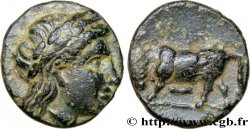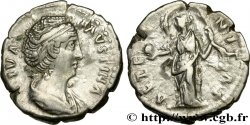v36_0151 - BITHYNIA - CHALCEDONIA Tétradrachme
MONNAIES 36 (2008)
Starting price : 450.00 €
Estimate : 750.00 €
Realised price : 450.00 €
Number of bids : 1
Maximum bid : 1 100.00 €
Starting price : 450.00 €
Estimate : 750.00 €
Realised price : 450.00 €
Number of bids : 1
Maximum bid : 1 100.00 €
Type : Tétradrachme
Date: c. 250-230 AC.
Mint name / Town : Chalcédoine
Metal : silver
Diameter : 28,5 mm
Orientation dies : 11 h.
Weight : 16,66 g.
Rarity : R1
Coments on the condition:
Exemplaire parfaitement centré des deux côtés sur un petit flan complet. Beau portrait ramassé. Revers de style grêle, légèrement stylisé. Jolie patine grise superficielle avec des reflets dorés
Catalogue references :
Predigree :
Cet exemplaire provient de la vente Lanz 117, 24 novembre 2003, n° 194
Obverse
Obverse legend : ANÉPIGRAPHE.
Obverse description : Tête imberbe d'Alexandre le Grand sous les traits de Zeus-Ammon, cornu et diadémé à droite.
Reverse
Reverse description : Athéna nicéphore assise à gauche sur un trône, tenant une petite Niké de la main droite qui couronne le nom de Lysimaque et le coude gauche reposant sur un bouclier orné d'un masque de lion ; le trône est orné d’un rinceau ; épi de blé couché à gauche.
Reverse legend : BASILEWS/ LUSIMACOU/ AG, (Bsilews Lusimacou)
Reverse translation : (du roi Lysimaque).
Commentary
Précédemment ce type était attribué à l’atelier de Callatis. Il faut rendre ce monnayage à l’atelier de Chalcédoine. Le monnayage est posthume, frappé dans la seconde moitié du IIIe siècle avant J.-C. Ce tétradrachme est parfois daté du troisième quart du IIIe siècle avant J.-C.
Previously this type was attributed to the Callatis mint. This coinage must be attributed to the Chalcedon mint. The coinage is posthumous, struck in the second half of the 3rd century BC. This tetradrachm is sometimes dated to the third quarter of the 3rd century BC.
Previously this type was attributed to the Callatis mint. This coinage must be attributed to the Chalcedon mint. The coinage is posthumous, struck in the second half of the 3rd century BC. This tetradrachm is sometimes dated to the third quarter of the 3rd century BC.








 Report a mistake
Report a mistake Print the page
Print the page Share my selection
Share my selection Ask a question
Ask a question Consign / sell
Consign / sell










